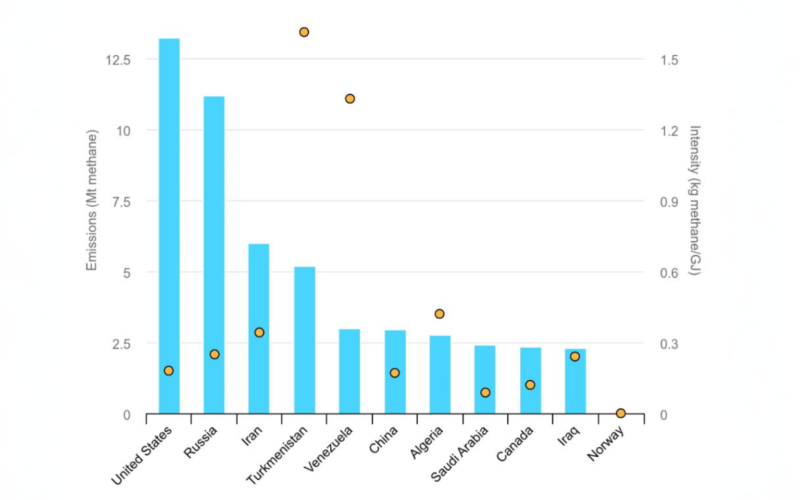A new analysis by the International Energy Agency (IEA) reveals that fully implementing existing methane reduction pledges would achieve most, but not all, of the emissions cuts required this decade to meet the 1.5°C target. Methane emissions from the energy sector remained near record levels in 2023. However, recent policies and regulations, along with new commitments from the COP28 climate summit in Dubai, could soon drive emissions down, according to the IEA’s Global Methane Tracker.
The analysis shows that fossil fuel production and use generated nearly 120 million tonnes of methane in 2023, a slight increase from 2022. An additional 10 million tonnes came from bioenergy, mainly from traditional biomass used for cooking. The top 10 emitting countries contributed about 80 million tonnes of fossil fuel-related methane emissions, two-thirds of the global total. The United States, the largest oil and gas producer, led emissions from these sectors, followed closely by Russia, while China was the highest emitter from coal.
Satellites have improved the accuracy of methane emission data, and the report highlights a significant rise in major fossil fuel leaks in 2023, with over 5 million tonnes of methane detected, including a prolonged well blowout in Kazakhstan that went on for over 200 days.
Global methane emissions are still too high to meet international climate targets. To limit warming to 1.5°C, a key goal of the Paris Agreement, the IEA reports that methane emissions from fossil fuels must be reduced by 75% this decade.
IEA Executive Director Fatih Birol said, “Now, we must focus on transforming commitments into action – while continuing to aim higher. Well known policies and existing technologies could reduce methane emissions from fossil fuels substantially. The IEA stands ready to help the energy sector meet its goals by deploying these measures, and we will continue to monitor progress – a key part of our wider efforts to ensure countries deliver on the energy promises they made at COP28.”
Efforts to reduce methane emissions are expected to gain momentum in 2024 and beyond, following COP28’s increase in ambition. Nearly 200 governments agreed in Dubai to substantially cut methane emissions by 2030. Major regulatory initiatives were introduced by Canada, the EU, and the US around the summit, and new commitments have emerged, including the Oil and Gas Decarbonisation Charter and additional countries joining the Global Methane Pledge, with Azerbaijan set to host COP29.
The IEA’s new analysis reveals that if all methane pledges made by countries and companies are fully implemented and timely, they could reduce methane emissions from fossil fuels by 50% by 2030. However, many of these pledges lack concrete implementation plans.
Methane, which accounts for nearly a third of the increase in global temperatures since the Industrial Revolution, is a major contributor to global warming. The energy sector—encompassing oil, natural gas, coal, and bioenergy—is the second-largest source of methane emissions. Although methane dissipates faster than carbon dioxide, it is a much more potent greenhouse gas in the short term. Therefore, reducing methane emissions is a highly effective strategy for limiting global warming and improving air quality.
Moreover, methane mitigation is cost-effective. The IEA’s analysis shows that approximately 40% of methane emissions from fossil fuel operations in 2023 could have been avoided at no net cost, as the value of captured methane outweighed the costs of abatement measures. Cutting methane emissions from fossil fuels by 75% by 2030 would require about USD 170 billion in investment—less than 5% of the fossil fuel industry’s revenue in 2023.






















